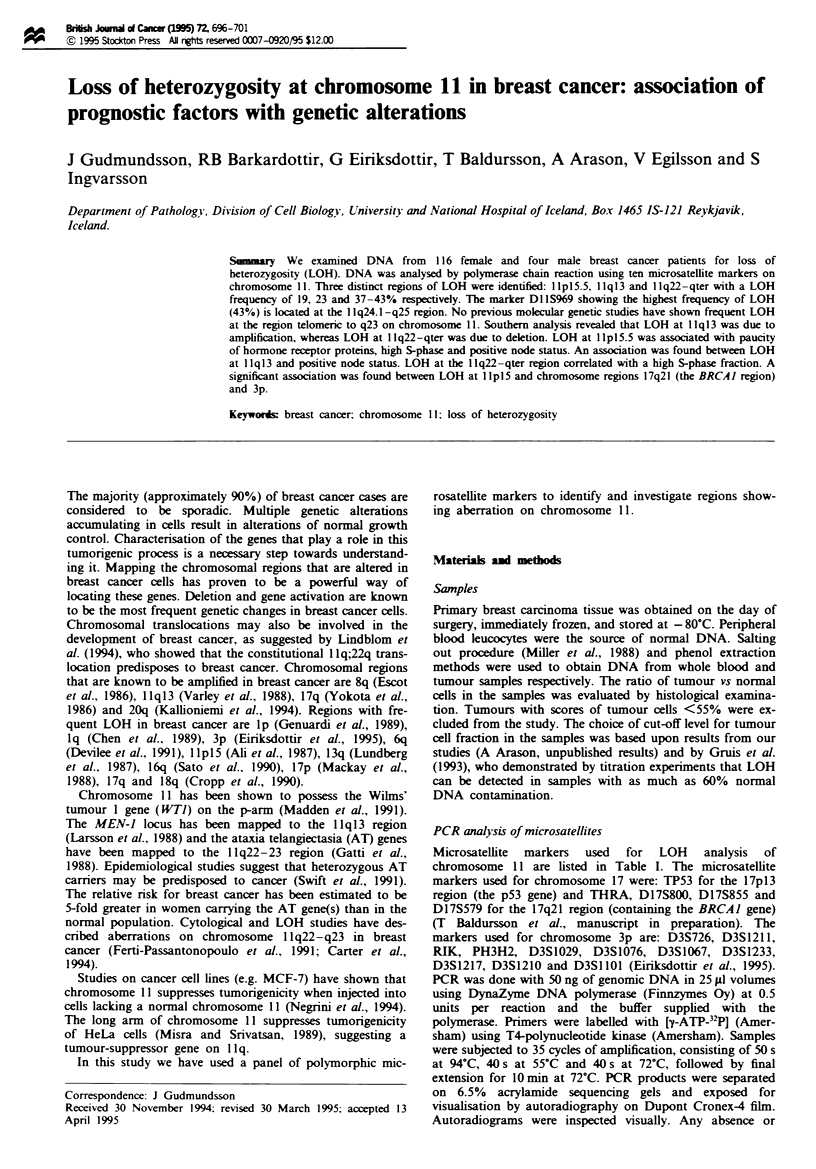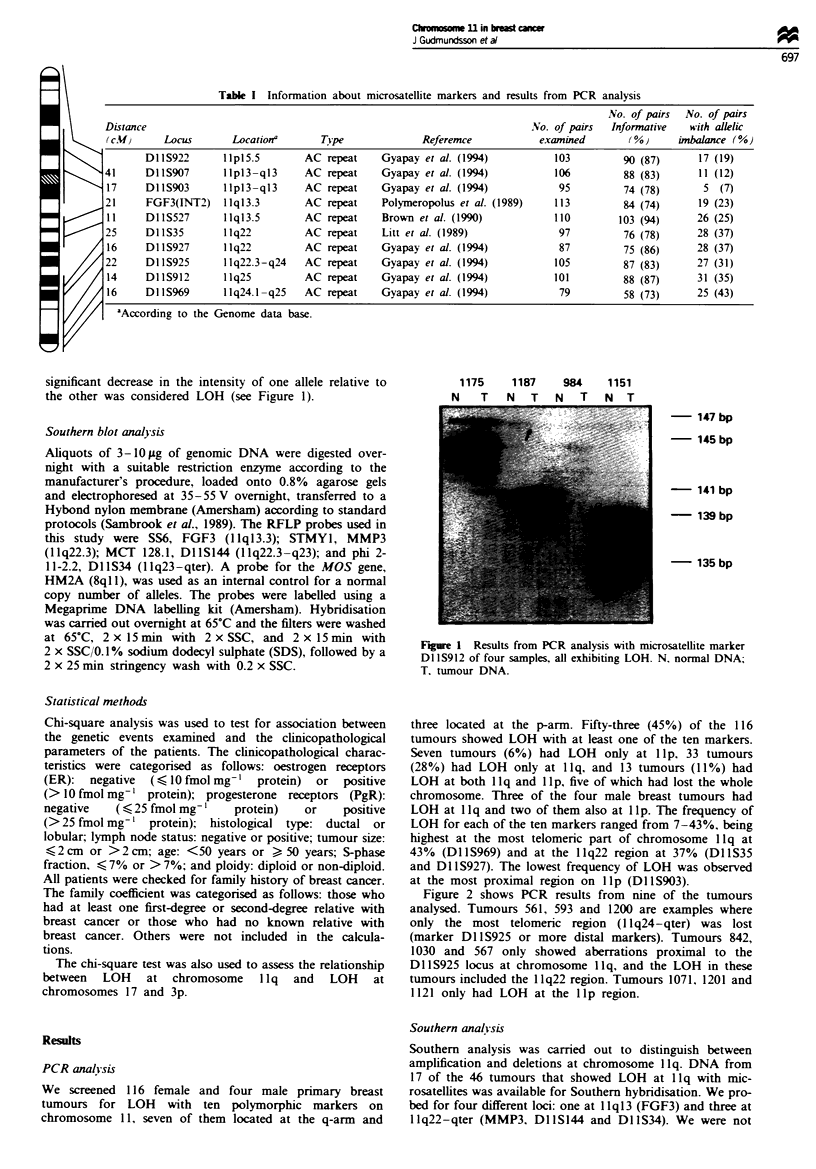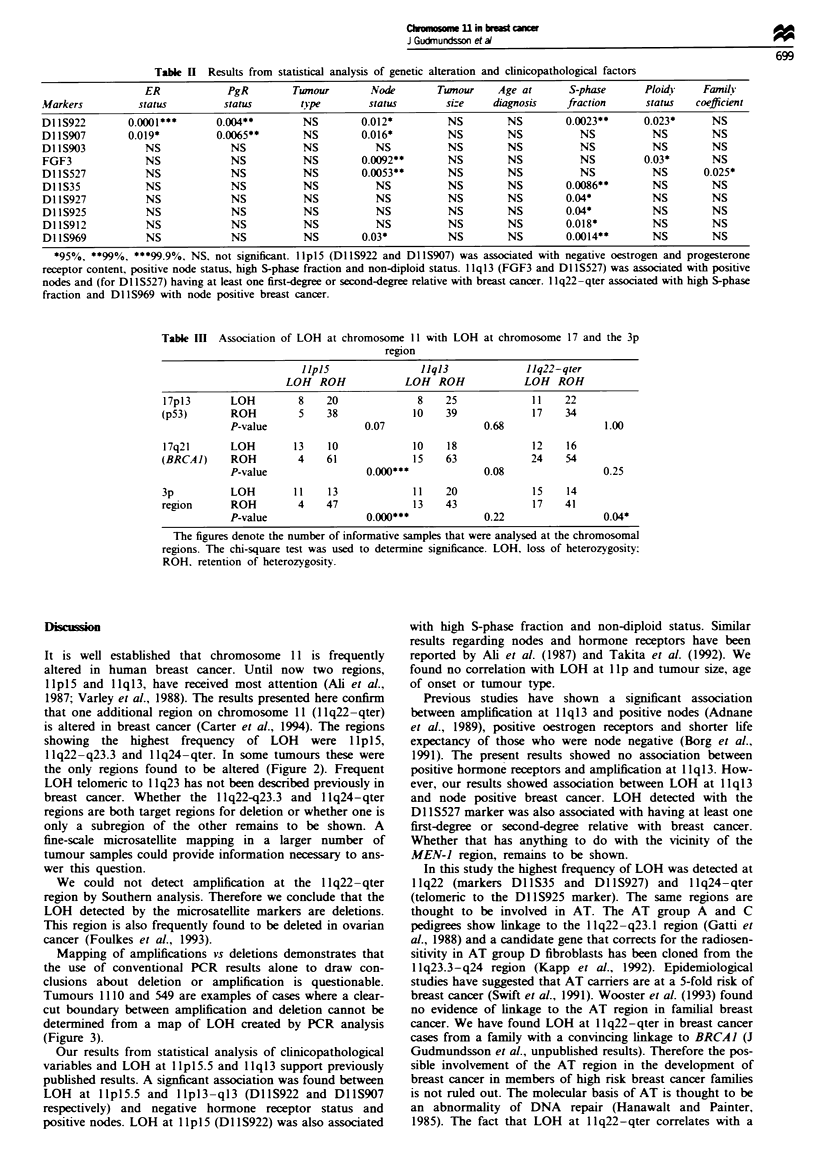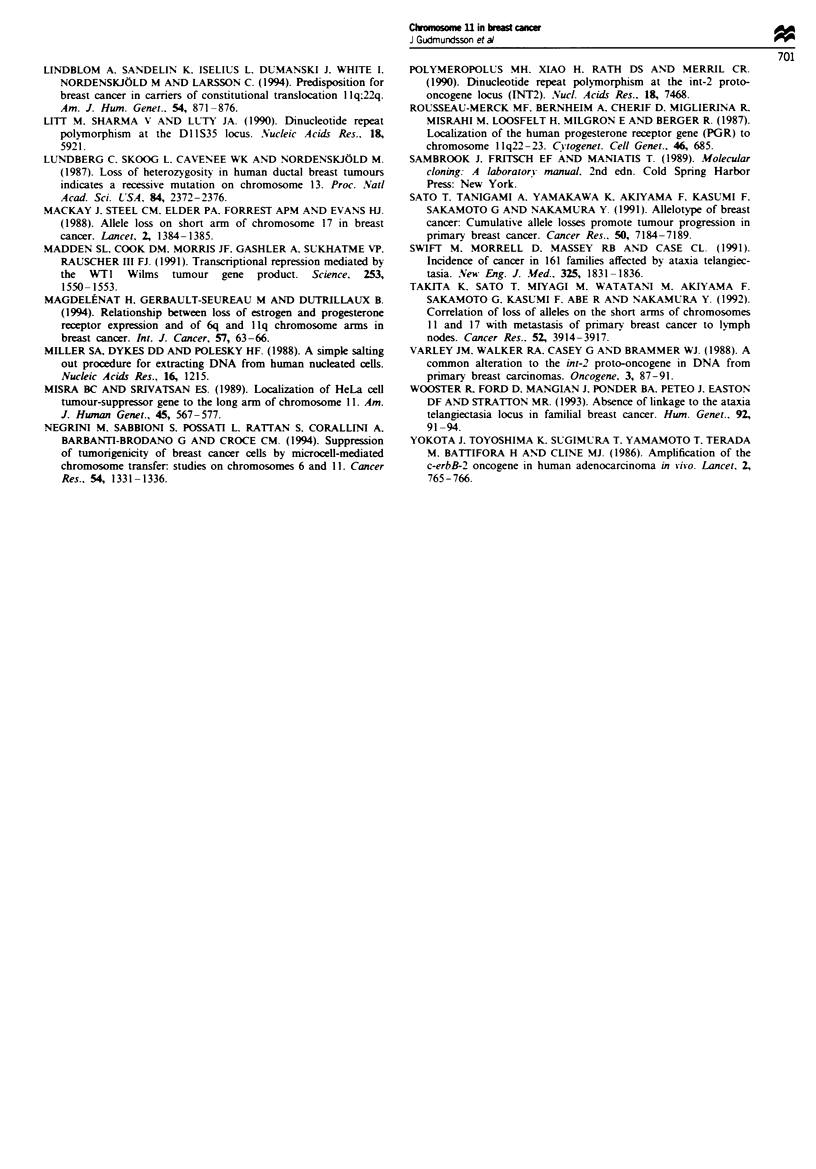Abstract
We examined DNA from 116 female and four male breast cancer patients for loss of heterozygosity (LOH). DNA was analysed by polymerase chain reaction using ten microsatellite markers on chromosome 11. Three distinct regions of LOH were identified: 11p15.5, 11q13 and 11q22-qter with a LOH frequency of 19, 23 and 37-43% respectively. The marker D11S969 showing the highest frequency of LOH (43%) is located at the 11q24.1-q25 region. No previous molecular genetic studies have shown frequent LOH at the region telomeric to q23 on chromosome 11. Southern analysis revealed that LOH at 11q13 was due to amplification, whereas LOH at 11q22qter was due to deletion. LOH at 11p15.5 was associated with paucity of hormone receptor proteins, high S-phase and positive node status. An association was found between LOH at 11q13 and positive node status. LOH at the 11q22-qter region correlated with a high S-phase fraction. A significant association was found between LOH at 11p15 and chromosome regions 17q21 (the BRCA1 region) and 3p.
Full text
PDF





Images in this article
Selected References
These references are in PubMed. This may not be the complete list of references from this article.
- Adnane J., Gaudray P., Simon M. P., Simony-Lafontaine J., Jeanteur P., Theillet C. Proto-oncogene amplification and human breast tumor phenotype. Oncogene. 1989 Nov;4(11):1389–1395. [PubMed] [Google Scholar]
- Ali I. U., Lidereau R., Theillet C., Callahan R. Reduction to homozygosity of genes on chromosome 11 in human breast neoplasia. Science. 1987 Oct 9;238(4824):185–188. doi: 10.1126/science.3659909. [DOI] [PubMed] [Google Scholar]
- Borg A., Sigurdsson H., Clark G. M., Fernö M., Fuqua S. A., Olsson H., Killander D., McGurie W. L. Association of INT2/HST1 coamplification in primary breast cancer with hormone-dependent phenotype and poor prognosis. Br J Cancer. 1991 Jan;63(1):136–142. doi: 10.1038/bjc.1991.28. [DOI] [PMC free article] [PubMed] [Google Scholar]
- Browne D. L., Gault J., Thompson M. B., Hauge X. Y., Evans G. A., Litt M. Dinucleotide repeat polymorphism at the D11S527 locus. Nucleic Acids Res. 1991 Sep 11;19(17):4790–4790. doi: 10.1093/nar/19.17.4790-a. [DOI] [PMC free article] [PubMed] [Google Scholar]
- Carter S. L., Negrini M., Baffa R., Gillum D. R., Rosenberg A. L., Schwartz G. F., Croce C. M. Loss of heterozygosity at 11q22-q23 in breast cancer. Cancer Res. 1994 Dec 1;54(23):6270–6274. [PubMed] [Google Scholar]
- Chen L. C., Dollbaum C., Smith H. S. Loss of heterozygosity on chromosome 1q in human breast cancer. Proc Natl Acad Sci U S A. 1989 Sep;86(18):7204–7207. doi: 10.1073/pnas.86.18.7204. [DOI] [PMC free article] [PubMed] [Google Scholar]
- Devilee P., van Vliet M., van Sloun P., Kuipers Dijkshoorn N., Hermans J., Pearson P. L., Cornelisse C. J. Allelotype of human breast carcinoma: a second major site for loss of heterozygosity is on chromosome 6q. Oncogene. 1991 Sep;6(9):1705–1711. [PubMed] [Google Scholar]
- Escot C., Theillet C., Lidereau R., Spyratos F., Champeme M. H., Gest J., Callahan R. Genetic alteration of the c-myc protooncogene (MYC) in human primary breast carcinomas. Proc Natl Acad Sci U S A. 1986 Jul;83(13):4834–4838. doi: 10.1073/pnas.83.13.4834. [DOI] [PMC free article] [PubMed] [Google Scholar]
- Ferti-Passantonopoulou A., Panani A. D., Raptis S. Preferential involvement of 11q23-24 and 11p15 in breast cancer. Cancer Genet Cytogenet. 1991 Feb;51(2):183–188. doi: 10.1016/0165-4608(91)90130-m. [DOI] [PubMed] [Google Scholar]
- Foulkes W. D., Campbell I. G., Stamp G. W., Trowsdale J. Loss of heterozygosity and amplification on chromosome 11q in human ovarian cancer. Br J Cancer. 1993 Feb;67(2):268–273. doi: 10.1038/bjc.1993.51. [DOI] [PMC free article] [PubMed] [Google Scholar]
- Gatti R. A., Berkel I., Boder E., Braedt G., Charmley P., Concannon P., Ersoy F., Foroud T., Jaspers N. G., Lange K. Localization of an ataxia-telangiectasia gene to chromosome 11q22-23. Nature. 1988 Dec 8;336(6199):577–580. doi: 10.1038/336577a0. [DOI] [PubMed] [Google Scholar]
- Genuardi M., Tsihira H., Anderson D. E., Saunders G. F. Distal deletion of chromosome Ip in ductal carcinoma of the breast. Am J Hum Genet. 1989 Jul;45(1):73–82. [PMC free article] [PubMed] [Google Scholar]
- Gruis N. A., Abeln E. C., Bardoel A. F., Devilee P., Frants R. R., Cornelisse C. J. PCR-based microsatellite polymorphisms in the detection of loss of heterozygosity in fresh and archival tumour tissue. Br J Cancer. 1993 Aug;68(2):308–313. doi: 10.1038/bjc.1993.333. [DOI] [PMC free article] [PubMed] [Google Scholar]
- Gyapay G., Morissette J., Vignal A., Dib C., Fizames C., Millasseau P., Marc S., Bernardi G., Lathrop M., Weissenbach J. The 1993-94 Généthon human genetic linkage map. Nat Genet. 1994 Jun;7(2 Spec No):246–339. doi: 10.1038/ng0694supp-246. [DOI] [PubMed] [Google Scholar]
- Hanawalt P., Painter R. On the nature of a "DNA-processing" defect in ataxia-telangiectasia. Kroc Found Ser. 1985;19:67–71. [PubMed] [Google Scholar]
- Kallioniemi A., Kallioniemi O. P., Piper J., Tanner M., Stokke T., Chen L., Smith H. S., Pinkel D., Gray J. W., Waldman F. M. Detection and mapping of amplified DNA sequences in breast cancer by comparative genomic hybridization. Proc Natl Acad Sci U S A. 1994 Mar 15;91(6):2156–2160. doi: 10.1073/pnas.91.6.2156. [DOI] [PMC free article] [PubMed] [Google Scholar]
- Kapp L. N., Painter R. B., Yu L. C., van Loon N., Richard C. W., 3rd, James M. R., Cox D. R., Murnane J. P. Cloning of a candidate gene for ataxia-telangiectasia group D. Am J Hum Genet. 1992 Jul;51(1):45–54. [PMC free article] [PubMed] [Google Scholar]
- Larsson C., Skogseid B., Oberg K., Nakamura Y., Nordenskjöld M. Multiple endocrine neoplasia type 1 gene maps to chromosome 11 and is lost in insulinoma. Nature. 1988 Mar 3;332(6159):85–87. doi: 10.1038/332085a0. [DOI] [PubMed] [Google Scholar]
- Lindblom A., Sandelin K., Iselius L., Dumanski J., White I., Nordenskjöld M., Larsson C. Predisposition for breast cancer in carriers of constitutional translocation 11q;22q. Am J Hum Genet. 1994 May;54(5):871–876. [PMC free article] [PubMed] [Google Scholar]
- Litt M., Sharma V., Luty J. A. Dinucleotide repeat polymorphism at the D11S35 locus. Nucleic Acids Res. 1990 Oct 11;18(19):5921–5921. doi: 10.1093/nar/18.19.5921-a. [DOI] [PMC free article] [PubMed] [Google Scholar]
- Lundberg C., Skoog L., Cavenee W. K., Nordenskjöld M. Loss of heterozygosity in human ductal breast tumors indicates a recessive mutation on chromosome 13. Proc Natl Acad Sci U S A. 1987 Apr;84(8):2372–2376. doi: 10.1073/pnas.84.8.2372. [DOI] [PMC free article] [PubMed] [Google Scholar]
- Mackay J., Steel C. M., Elder P. A., Forrest A. P., Evans H. J. Allele loss on short arm of chromosome 17 in breast cancers. Lancet. 1988 Dec 17;2(8625):1384–1385. doi: 10.1016/s0140-6736(88)90584-3. [DOI] [PubMed] [Google Scholar]
- Madden S. L., Cook D. M., Morris J. F., Gashler A., Sukhatme V. P., Rauscher F. J., 3rd Transcriptional repression mediated by the WT1 Wilms tumor gene product. Science. 1991 Sep 27;253(5027):1550–1553. doi: 10.1126/science.1654597. [DOI] [PubMed] [Google Scholar]
- Magdelénat H., Gerbault-Seureau M., Dutrillaux B. Relationship between loss of estrogen and progesterone receptor expression and of 6q and 11q chromosome arms in breast cancer. Int J Cancer. 1994 Apr 1;57(1):63–66. doi: 10.1002/ijc.2910570112. [DOI] [PubMed] [Google Scholar]
- Miller S. A., Dykes D. D., Polesky H. F. A simple salting out procedure for extracting DNA from human nucleated cells. Nucleic Acids Res. 1988 Feb 11;16(3):1215–1215. doi: 10.1093/nar/16.3.1215. [DOI] [PMC free article] [PubMed] [Google Scholar]
- Misra B. C., Srivatsan E. S. Localization of HeLa cell tumor-suppressor gene to the long arm of chromosome II. Am J Hum Genet. 1989 Oct;45(4):565–577. [PMC free article] [PubMed] [Google Scholar]
- Negrini M., Sabbioni S., Possati L., Rattan S., Corallini A., Barbanti-Brodano G., Croce C. M. Suppression of tumorigenicity of breast cancer cells by microcell-mediated chromosome transfer: studies on chromosomes 6 and 11. Cancer Res. 1994 Mar 1;54(5):1331–1336. [PubMed] [Google Scholar]
- Polymeropoulos M. H., Xiao H., Rath D. S., Merril C. R. Dinucleotide repeat polymorphism at the int-2 proto-oncogene locus (INT2). Nucleic Acids Res. 1990 Dec 25;18(24):7468–7468. [PMC free article] [PubMed] [Google Scholar]
- Sato T., Tanigami A., Yamakawa K., Akiyama F., Kasumi F., Sakamoto G., Nakamura Y. Allelotype of breast cancer: cumulative allele losses promote tumor progression in primary breast cancer. Cancer Res. 1990 Nov 15;50(22):7184–7189. [PubMed] [Google Scholar]
- Swift M., Morrell D., Massey R. B., Chase C. L. Incidence of cancer in 161 families affected by ataxia-telangiectasia. N Engl J Med. 1991 Dec 26;325(26):1831–1836. doi: 10.1056/NEJM199112263252602. [DOI] [PubMed] [Google Scholar]
- Takita K., Sato T., Miyagi M., Watatani M., Akiyama F., Sakamoto G., Kasumi F., Abe R., Nakamura Y. Correlation of loss of alleles on the short arms of chromosomes 11 and 17 with metastasis of primary breast cancer to lymph nodes. Cancer Res. 1992 Jul 15;52(14):3914–3917. [PubMed] [Google Scholar]
- Wooster R., Ford D., Mangion J., Ponder B. A., Peto J., Easton D. F., Stratton M. R. Absence of linkage to the ataxia telangiectasia locus in familial breast cancer. Hum Genet. 1993 Aug;92(1):91–94. doi: 10.1007/BF00216153. [DOI] [PubMed] [Google Scholar]
- Yokota J., Yamamoto T., Toyoshima K., Terada M., Sugimura T., Battifora H., Cline M. J. Amplification of c-erbB-2 oncogene in human adenocarcinomas in vivo. Lancet. 1986 Apr 5;1(8484):765–767. doi: 10.1016/s0140-6736(86)91782-4. [DOI] [PubMed] [Google Scholar]




